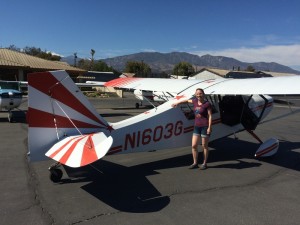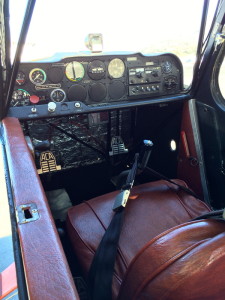How to spin a plane
July 5th, 2015 at 1:20 pm (Flying)
 Spins are one of the bugaboos of flight training. Dangerous, lethal, do not go here! A spin happens from a stall in which the pilot allows one wing to drop, sending the plane into a spinning dive at the ground, as shown at right. (In an airshow, where pilots deliberately spin, they use smoke so you can see a trace of the path.) In a spin, the plane may descend at 500 feet *per second*. Inadvertent spins that happen close to the ground are almost always lethal, since you don’t have time to do anything to fix it.
Spins are one of the bugaboos of flight training. Dangerous, lethal, do not go here! A spin happens from a stall in which the pilot allows one wing to drop, sending the plane into a spinning dive at the ground, as shown at right. (In an airshow, where pilots deliberately spin, they use smoke so you can see a trace of the path.) In a spin, the plane may descend at 500 feet *per second*. Inadvertent spins that happen close to the ground are almost always lethal, since you don’t have time to do anything to fix it.
In flight training, we are taught to actively avoid spins. We’re required to practice stalls and how to recover from them, and especially how to keep them from developing into a spin, but we are not allowed to practice spins themselves. We memorize the theoretical steps that would be used to recover from a spin, but we never get to do it. I feel uneasy knowing about a bad condition and not getting any practical experience. What if it happened and I froze up? Or couldn’t figure out how to execute those memorized theoretical steps? So, my instructor encouraged me to go to an aerobatic school and get exactly that experience. It’s a bit like taking your car out in the snowy parking lot and skidding around on purpose to feel that loss of control and learn how to regain it.
As a super awesome birthday gift, my boyfriend arranged for us to get a spin training lesson at CP Aviation (btw, I love their logo). We sat down for an hour of ground instruction, in which we reviewed the aerodynamics of stalls and spins, and then he walked us through what we would do in the air. We were flying a red and white Citabria, which was my first experience with a tailwheel plane.

It is covered in fabric, not metal! It has no flaps! And the controls are VERY different from those of the Cessna Skyhawk I usually fly. Instead of a yoke, there is a stick between your legs. The throttle is a slider in the wall of the cabin on your left. So’s the carb heat and the elevator trim. The instruments are minimal — you have airspeed, altitude, and a turn coordinator. There is no attitude indicator, no VSI (vertical speed indicator), no heading indicator, no compass. You sit in this plane in tandem: you in front and the instructor behind. This gives you an awesome feeling of flying alone with a disembodied guardian angel floating over your shoulder and giving you directions. It also means that the instructor cannot see the few instruments there are. My instructor judges airspeed by looking out at the wing angles. And he’s good! (He recommended using this cue in my Cessna flying as well.)

I loved flying this plane. It was so responsive to the slightest move on the stick or the rudders. It felt delicate but strong at the same time. I sometimes feel like I have to wrestle with the Skyhawk to get it to do what needs to be done, but I only had to nudge the Citabria.
 We went up and first practiced Dutch rolls, which I already knew and liked; they are a chance to practice good rudder control as you roll the plane left, right, left, right, while keeping the nose at the same pointing. Then we did power-off stalls and recovery (also something I’m familiar with), and then something called a falling-leaf stall. This is when you go into a stall and don’t recover, then work the rudders to *prevent* a spin. So the plane is sinking downward and keeps wanting to yaw off to the left or right, and you dance on the rudder pedals to compensate. I guess the diagram at right is what the plane is supposed to be doing, but from inside the cockpit it instead felt like riding a bucking bronco. The nose would yaw left and right, but it also bobbed up and down in an oscillation at the same time (fortunately, the instructor had warned me about this first).
We went up and first practiced Dutch rolls, which I already knew and liked; they are a chance to practice good rudder control as you roll the plane left, right, left, right, while keeping the nose at the same pointing. Then we did power-off stalls and recovery (also something I’m familiar with), and then something called a falling-leaf stall. This is when you go into a stall and don’t recover, then work the rudders to *prevent* a spin. So the plane is sinking downward and keeps wanting to yaw off to the left or right, and you dance on the rudder pedals to compensate. I guess the diagram at right is what the plane is supposed to be doing, but from inside the cockpit it instead felt like riding a bucking bronco. The nose would yaw left and right, but it also bobbed up and down in an oscillation at the same time (fortunately, the instructor had warned me about this first).
Finally we got to do the actual spins. Here you slow down (not quite to a stall) and then deliberately press full right (or left) rudder and then pull back on the stick. The plane yaws and banks off to the right and then dives at the ground. You get to watch the ground rotating around in front of your face while you count off rotations and then initiate the recovery. This was, oddly, not scary. I felt in control of the plane the whole time. My instructor emphasized “owning” the spin — you choose when it starts and when it ends. This is much better than feeling that you must react to some inexplicable thing the plane is doing. We did 1-turn (incipient) and 2-turn (fully developed, tighter, faster) spins. I felt like a rockstar in an airshow!
The recovery from a power-off spin is quite simple, and the main challenge is not getting distracted or disoriented by what is going on outside. To exit the spin, you just press full opposite rudder and gently let the stick move a little forward. (Emphasis on gently. The handbook for the Skyhawk advises “briskly pushing the elevator forward” but the Citabria only needs you to relax it a little. Doing too much gets you into a power dive.) Once the rotation stops, you’re still plummeting towards the ground, so you need to ease up out of it to get flying straight and level again. Practicing up high, this isn’t bad. If you ended up near the ground, it would be SO SO tempting to yank back on the stick, which you MUST NOT do, lest you stall yourself at high speed and impact the ground anyway. Of course, if you are low enough, then you will be out of options, which is also why (unintentional) spins have killed a lot of people.
We then flew back to the airport, and my instructor landed the plane since I have no tailwheel experience (the Skyhawk I fly is a “tricycle gear” plane with a nosewheel in front). He let me follow him on the controls, though, which was fun. He did a very short final approach, used a slip to lose altitude (which felt much smoother and natural than slips do in the Skyhawk!), and we were down.
CP Aviation offers a series of lessons on “emergency maneuver and aerobatics training.” We did a mixture of lessons 1 and 2. I’d love to go back for more!
jim said,
July 5, 2015 at 4:28 pm
How fun and awesome! Happy birthday, Kiri!
What I Learned Today » Blog Archive » Why I want to learn more aerobatics said,
November 8, 2015 at 8:04 pm
[…] been trying to put my finger on why my spin training lesson was so enjoyable. I think it comes down to feeling that much of my current regular training is […]
What I Learned Today » Blog Archive » Private pilot checkride said,
March 11, 2016 at 9:55 am
[…] – my photo id, medical certificate, and logbook experience. He noticed that I had done a spin training lesson and approved! We also went over the airplane’s logbooks, which I had borrowed from the […]